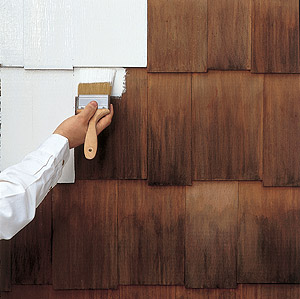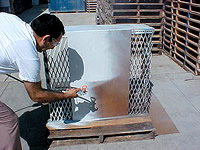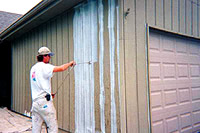
...continued from previous page
Paint Primers:
Low VOC Paint
Primers are changing in the wake of new laws regulating VOC content.
by Christina Camara
low-VOC products in heated trucks; some suppliers don’t ship at all during cold weather; others urge their distributors to build up their supplies before winter. “There will be a lot of jockeying so latex coatings and primers aren’t out in harm’s way,” Hardy said.
Dave Thompson, director of technical services and professional sales of California Paints of Andover, Mass., said the very low-VOC products dry more quickly as the sheens go up the scale. Also, California Paints doesn’t offer anything darker than a pastel base in the low-VOC paints because the colorants in the darker bases contain VOCs, making it no different than regular paint. The low-VOC paints don’t hide quite as well either, he says, which could mean an additional coat.
“They do have some drawbacks,” he said, “which is why we don’t make all our of products that way.”
Thompson said California Paints does not offer a low-VOC primer, instead recommending use of a low-VOC finish coat to act as the primer. Unless contractors are facing a serious adhesion problem or bleeding stains, a finish coat would work perfectly well as a primer. He added, “Two good finish coats will work better than a cheap primer and a good finish coat.”
One of the big selling points of the low- or no-VOC products is the lack of odor. That’s why hospital administrators and health care professionals are particularly interested in low-VOC products.
O’Reilly said government agencies sometimes choose low-VOC products as one way to reduce their overall air emissions. Other buyers of zero-VOC products tend to be big corporations that set aside part of their capital improvements budget to “green” building projects.
 |
 |
 |
 |
| From Top to Bottom: Low-VOC water-reducible primer being applied by spray to structural grate. Low-VOC high-build bonding primer being applied to rough-sawn siding. Low-VOC water-reducible corrosion-control primer being applied to support angle iron in a bulk chemical loading dock. Low-VOC solvent-based primer that uses exempt solvent. |
Architects designing green buildings have turned to Benjamin Moore’s Eco Spec line of four paint products. Made without solvents, the line has been recognized by two independent organizations that certify environmentally friendly products, Green Seal and Green Guard.
Benjamin Moore says that modern low-VOC coatings can be very good paints, but they may require slightly different techniques to get the best results. The overall full cure time of these products is generally longer than traditional paints.
Hardy agrees. “Give it time, it cures differently.” The film may feel softer. Contractors can scratch the surface with a fingernail to test for adhesion, but they may be fooled if the surface isn’t fully cured.
“Our recommendation is that as the contractor finds himself having to look at new formulas and products — even from companies that he’s familiar with — test first.”
Low-VOC primers and paints will spray on differently, O’Reilly said. “They may need to use a little larger tip, and it’ll take an hour longer dry time, but the reality is, that doesn’t impact most contractors, they can still do their second coat in a day.”
He also said that adding thinner may push the primer over the VOC limit. “They don’t want to get caught doing that, because it could mean big fines,” O’Reilly said.
Steve Revnew, Sherwin-Williams’ director of Marketing, Architectural Segments, Residential Products, said the company’s Harmony line of paints includes a low-VOC primer. “These primers should apply similar to higher-VOC products. In other words, the contractor should see or feel little to no difference between the products.” Thinning the product could hurt performance, he said. “Our products are formulated to provide the right amount of flow and leveling as well as give you the desired application without adding anything to the product.”
 Hardy said, “Understanding the rules, the differences in application, cure time, understanding the film thicknesses, it’s all part of the change.” He recognizes that new regulations and new products can be confusing for manufacturers and contractors alike, “but out of it all the technology is slowly making gains,” he said. “We have coatings today that we didn’t have 10 years ago.” Hardy said, “Understanding the rules, the differences in application, cure time, understanding the film thicknesses, it’s all part of the change.” He recognizes that new regulations and new products can be confusing for manufacturers and contractors alike, “but out of it all the technology is slowly making gains,” he said. “We have coatings today that we didn’t have 10 years ago.”

|

